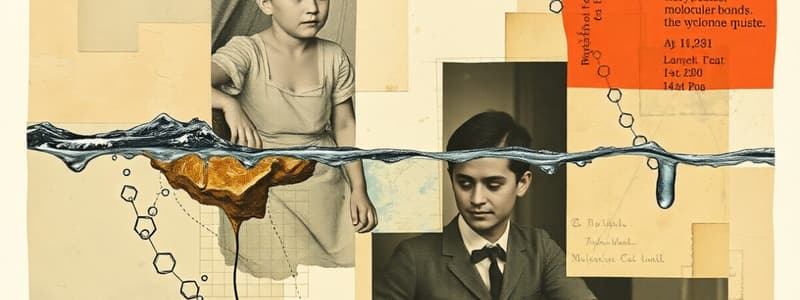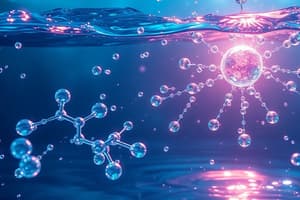Podcast
Questions and Answers
Water's polarity is primarily a result of what?
Water's polarity is primarily a result of what?
- The linear arrangement of hydrogen and oxygen atoms.
- The presence of ionic bonds between water molecules.
- Equal sharing of electrons between hydrogen and oxygen atoms.
- Unequal sharing of electrons between hydrogen and oxygen atoms. (correct)
Which of the following best describes the interaction between water molecules due to their polarity?
Which of the following best describes the interaction between water molecules due to their polarity?
- Covalent bonds
- Hydrogen bonds (correct)
- Ionic bonds
- Hydrophobic interactions
What property of water is primarily responsible for the phenomenon of surface tension?
What property of water is primarily responsible for the phenomenon of surface tension?
- Thermal conductivity
- Cohesion (correct)
- Adhesion
- Viscosity
Which of the following explains how water is transported from the roots to the leaves in plants?
Which of the following explains how water is transported from the roots to the leaves in plants?
Based on the properties of water, what would happen to solutes dissolved in aqueous solutions?
Based on the properties of water, what would happen to solutes dissolved in aqueous solutions?
What term describes substances that do not readily dissolve in water?
What term describes substances that do not readily dissolve in water?
How are lipids transported in the blood of animals, given their hydrophobic nature?
How are lipids transported in the blood of animals, given their hydrophobic nature?
What property of water allows aquatic organisms to survive in colder climates?
What property of water allows aquatic organisms to survive in colder climates?
Why is water considered more viscous than air?
Why is water considered more viscous than air?
Which adaptation helps the black-throated loon dive underwater more easily?
Which adaptation helps the black-throated loon dive underwater more easily?
What adaptation of the ringed seal helps it to conserve heat in cold Arctic waters?
What adaptation of the ringed seal helps it to conserve heat in cold Arctic waters?
Why are ringed seals particularly vulnerable to climate change?
Why are ringed seals particularly vulnerable to climate change?
What essential role does water play in the assembly of complex organic molecules?
What essential role does water play in the assembly of complex organic molecules?
Which of the following properties of water is most critical for maintaining a stable internal environment in organisms?
Which of the following properties of water is most critical for maintaining a stable internal environment in organisms?
According to the passage, where did the large bodies of water on Earth likely originate?
According to the passage, where did the large bodies of water on Earth likely originate?
What is the Goldilocks zone in the context of searching for extraterrestrial life?
What is the Goldilocks zone in the context of searching for extraterrestrial life?
Aside from being in the Goldilocks zone, what other planetary characteristic is vital for liquid water to exist on a planet's surface?
Aside from being in the Goldilocks zone, what other planetary characteristic is vital for liquid water to exist on a planet's surface?
How does water's polarity contribute to the formation of cell membranes?
How does water's polarity contribute to the formation of cell membranes?
Which of the following properties allows water to moderate temperature fluctuations within living organisms and aquatic environments?
Which of the following properties allows water to moderate temperature fluctuations within living organisms and aquatic environments?
If a planet orbits a hotter star than our Sun, how would its habitable zone differ compared to Earth's?
If a planet orbits a hotter star than our Sun, how would its habitable zone differ compared to Earth's?
Flashcards
Water Molecule Composition
Water Molecule Composition
Water is made of two hydrogen atoms covalently bonded to one oxygen atom (H2O).
Polarity
Polarity
Slight difference in charge that occurs at different poles of the water molecule.
Charge Distribution in Water
Charge Distribution in Water
Oxygen attracts electrons more strongly, forming a slightly negative charge (δ-); hydrogen, a slightly positive charge (δ+).
Hydrogen Bonds in Water
Hydrogen Bonds in Water
Signup and view all the flashcards
Cohesion of Water
Cohesion of Water
Signup and view all the flashcards
Adhesion of Water
Adhesion of Water
Signup and view all the flashcards
Buoyancy
Buoyancy
Signup and view all the flashcards
Viscosity
Viscosity
Signup and view all the flashcards
Thermal Conductivity
Thermal Conductivity
Signup and view all the flashcards
Specific Heat Capacity
Specific Heat Capacity
Signup and view all the flashcards
Hydrophilic
Hydrophilic
Signup and view all the flashcards
Hydrophobic
Hydrophobic
Signup and view all the flashcards
Goldilocks Zone
Goldilocks Zone
Signup and view all the flashcards
Study Notes
Water Composition
- Water consists of two hydrogen atoms covalently bonded to an oxygen atom, represented by the molecular formula H2O
Polarity of Water
- Electrons are not shared equally in water's covalent bonds, resulting in polarity
- Oxygen's higher electronegativity attracts electrons more strongly, resulting in a slightly negative charge (δ−)
- Hydrogen atoms have a weaker electron attraction, leading to a slightly positive charge (δ+)
- Polarity allows water to form weak associations with other polar molecules or charged ions
- Slightly negative poles (δ−) attract slightly positive poles (δ+) of other molecules, and vice versa.
Hydrogen Bonds
- Hydrogen bonds form as a consequence of polar covalent bonds within water molecules
- Hydrogen bonds are intermolecular associations formed by polar covalent molecules
- Hydrogen bonds form when a δ+ hydrogen atom is attracted to a δ− fluorine or nitrogen atom of another molecule
- They are stronger than other associations due to high electronegativity
- Hydrogen bonding is responsible for water's unique properties like thermal, cohesive, and solvent characteristics
Cohesion
- Water is cohesive, meaning water molecules stick to each other through hydrogen bonds
- Hydrogen bonding allows water to resist low levels of external force, creating surface tension
- Surface tension makes water dense enough for small organisms to move across it
- Water striders use long legs with microscopic hairs to trap air and increase buoyancy
Adhesion
- Water is adhesive, meaning water molecules stick to other polar or charged molecules
- Attraction to charged or polar surfaces, such as cellulose cell walls, allows capillary action, enabling water to flow against gravity
- Capillary action strength depends on the diameter of the pore through which water moves; smaller diameter = more action
- Capillary action is necessary for transporting water up plant stems via a transpiration stream
- Water vapor loss from leaves (evaporation) and water absorption by roots (osmosis) create a pressure gradient
- Water moves along this gradient via capillary action and cohesion, transported up the stem via narrow xylem vessels
- Capillary action also moves water through the soil from deeper water tables
- Soil type influences capillary action strength, affecting agricultural practices
Solvent Properties
- Water's capacity to dissolve many substances makes it important for metabolic reactions
- Solutes dissolved in aqueous solutions are more likely to collide with enzymes and undergo chemical reactions
- Water promotes enzyme activity by absorbing heat from exothermic reactions and maintaining acid-base neutrality
- Substances in metabolic reactions are either hydrophilic or hydrophobic
- Hydrophilic substances freely associate and dissolve in water, including polar molecules and ions
- Hydrophobic substances do not freely associate or dissolve in water, like large non-polar molecules (lipids)
Transport Properties
- Blood plasma in animals transports dissolved solutes (amino acids, simple sugars, wastes, and gases)
- Mineral ions are transported via xylem vessels, while dissolved nutrients are transported via phloem
- Lipids in animals are packaged with proteins to form water-soluble lipoproteins for blood transport
Physical Properties
- Physical properties such as buoyancy, viscosity, thermal conductivity, and specific heat capacity make water the medium of life
- Buoyancy is the upward force on an object in a medium determined by density
- Water is denser than air, allowing objects to float
- An object's capacity to float is determined by its relative weight
- Viscosity is a fluid's tendency to flow; more viscous fluids resist flow more
Viscosity of Water
- Water is more viscous than air due to hydrogen bonds, increasing friction between flowing molecules
- Dissolved solutes increase water's viscosity
- Thermal conductivity is a medium's ability to move heat across a temperature gradient
- Water absorbs and transfers heat more readily than air because water particles are packed tighter
Heat Capacity
- Specific heat capacity describes the energy needed to raise the temperature of 1g of a substance by 1ºC
- Water has a higher specific heat capacity than air (highest of any liquid) since its hydrogen bonds require more energy to break
- High specific heat capacity makes water an effective coolant
- Sweat absorbs a lot of thermal energy, releasing heat by latent heat of vaporization
Biological Adaptations
- Black-throated loons and ringed seals live in the Arctic and spend time on land and in water
- Loons have lighter, less dense bones, allowing them to float, and non-hollow bones, allowing them to dive
- Loons have difficulty walking on land due to rear leg placement, which enable them to propel through water
- Loon feathers form an interlocking structure which creates a barrier to water which prevents heat loss because water has a high thermal conductivity
Marine Animals
- Seals have denser bones than loons, which allows them to stay submerged while diving and makes them less buoyant
- Seals have streamlined bodies to better propel themselves through water
- Seals have an outer coat of air-trapping fur and a thick blubber layer to prevent heat loss
- Ringed seals do not have effective cooling mechanisms due to generally stable water temperatures (due to specific heat capacity/thermal conductivity)
Water Origins
- Earth's water may have originated from asteroids formed further from the Sun, where cooler temperatures allowed water to freeze as ice
- Asteroids colliding with Earth had achieved enough mass (and gravity) to retain water vapor and had cooled enough for it to condense
Extraterrestrial Water
- Liquid water is essential for searching other habitable planets with extraterrestrial lifeforms
- The Goldilocks zone is the range of distance from a star where the right temperatures exist for liquid water to exist on a planet
- Relevant distances depend on the star's size and temperature
- Habitable zone is farther from hotter stars because they're hotter
- Few planets in Goldilocks zones have suitable mass or atmosphere for liquid water to exist on the surface
Studying That Suits You
Use AI to generate personalized quizzes and flashcards to suit your learning preferences.





